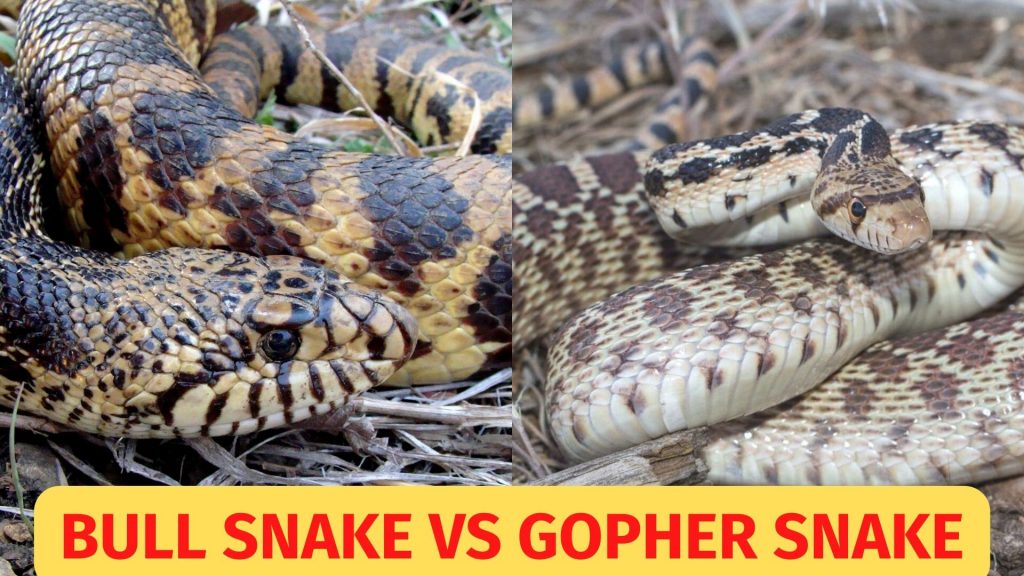Bull Snakes and other Gopher Snake subspecies are very similar. Let’s take a look at Bull Snake vs Gopher Snake habits and characteristics so that we can learn how to tell them apart…
Last updated on February 1st, 2023 at 09:27 am
The differences between the Bull Snake and the Gopher Snake are mainly in their size, coloration, range and scientific names. Bull Snakes are a subspecies of Gopher Snake, but they are larger and often have a more defined, darker coloration. They also occur further to the east than most other Gopher Snake subspecies.

How can you tell a gopher snake from a bull snake?
Bull Snakes and Gopher Snakes are pretty closely related to each other. Bull snakes are a subspecies, contained within the Gopher Snake species. Essentially, a Bull Snake is a type of Gopher Snake, but one which is different enough to warrant a slightly different scientific name.
They can be called cousins to each other. Hence, mostly they look very similar. However, they do have their similarities and differences, which are discussed in detail in the following article.
However, before further discussing the various aspects of the two, here is a brief about each.
Bull Snakes are found throughout the southern, central and southwestern parts of the United States. These are constrictors lacking venom.
Bull snakes make good pets since they are harmless around human beings. Bull snake care is also very easy, given how tough they are.
Gopher snakes are usually found in northern Mexico and the Western and South Western United States. There are several subspecies of Gopher snakes, one of which is that of the Bull Snake.
These are even less aggressive around human beings than the Bull Snakes. Hence, they are also kept as pets.
Size
Bull snakes start their life at 12-18 inches with a rapid growth tendency. On average, they grow about 4 feet in their adult life and can grow up to 8 feet long.
Obviously, this means that as captives Bull Snakes require a larger enclosure than many other common pet snakes.
The largest of them ever found was about 8 feet 4 inches long. Therefore, they clearly grow up to large sizes at times. These are not sexually dimorphic snakes so generally both sexes reach similar sizes.
Bull snakes are considered to be one of the largest colubrids in North America. Their body weight and size almost rivals that of Indigo snakes (Drymarchon).
On the other hand, gopher snakes start their life at one ft. and can grow up to 4 to 5 ft. maximum. This is one of the most significant differences between the two snakes.
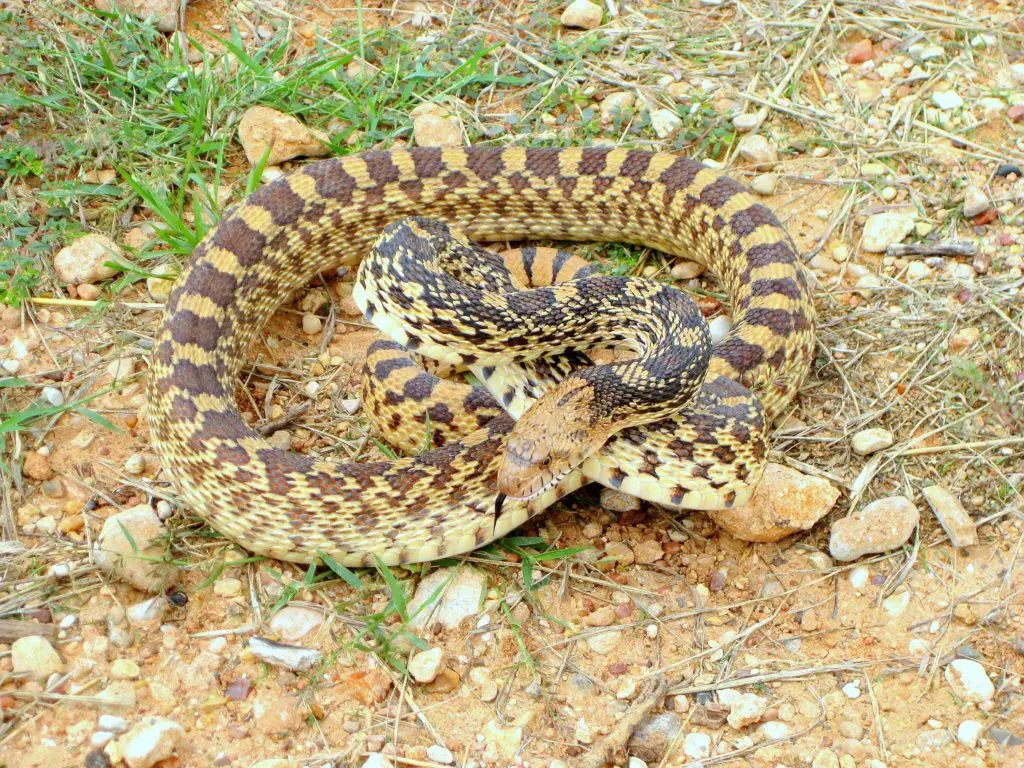
Coloration
Bull snakes are brightly colored species of snakes with patterns on their body. However, given how they have a significant natural distribution , color is a simple matter of variation. In the west of their range they may be considerably brighter than in the east.
That said, they almost always have darker patterning towards their head and tail.
These snakes can go from brightly colored to light-colored to even mostly black. However, they have a chain-like pattern on their backs, usually brown, yellow, yellowish brown or red colored.
In the case of Gopher snakes, they tend to have a lighter or paler color on their body. However, the patterns on their body are similar to that of the Bull snakes, i.e., the chain-like patterns. Often though, you’ll find the pattern on Gopher Snakes to be busier and less clear.
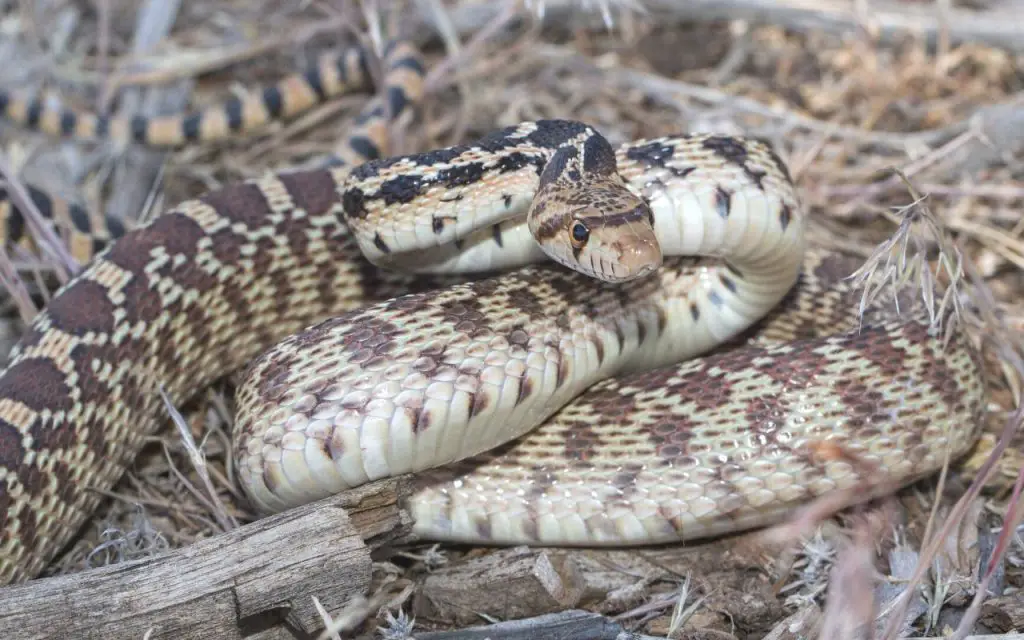
Range
Bull snakes can be found throughout the central, southern, and southwestern parts of the United States. They have a natural tendency to withstand a large variation in climatic conditions. Overall, their only sticking point is that they like plains habitat.
They are found in parts of Indiana in the east, Western Montana in the West, and southern Alberta and Saskatchewan in Canada. Gopher Snakes are found in the Northern parts of Mexico and the Western and South-Western parts of the United States, having more of a western distribution overall.
Let’s have a look at the distribution of the five most widespread Gopher Snake subspecies:
| Subspecies | Range |
| Bull Snake | Indiana in the east to Texas in the south. North to Alberata and Saskatchewan, and roughly as far west as the Rocky Mountains |
| Sonoran Gopher Snake | West Texas to southeast California. Most of New Mexica and Arizona, south as far as Zacatecas in Mexico |
| Great Basin Gopher Snake | Souther California, almost all of Nevada north to southern British Columbia |
| Pacific Gopher Snake | Western Oregon and most of California west of the Sierra Nevada, almost as far south as Santa Barbara |
| San Diego Gopher Snake | Southern California (from Santa Barbara county) down to Northern Baja California |
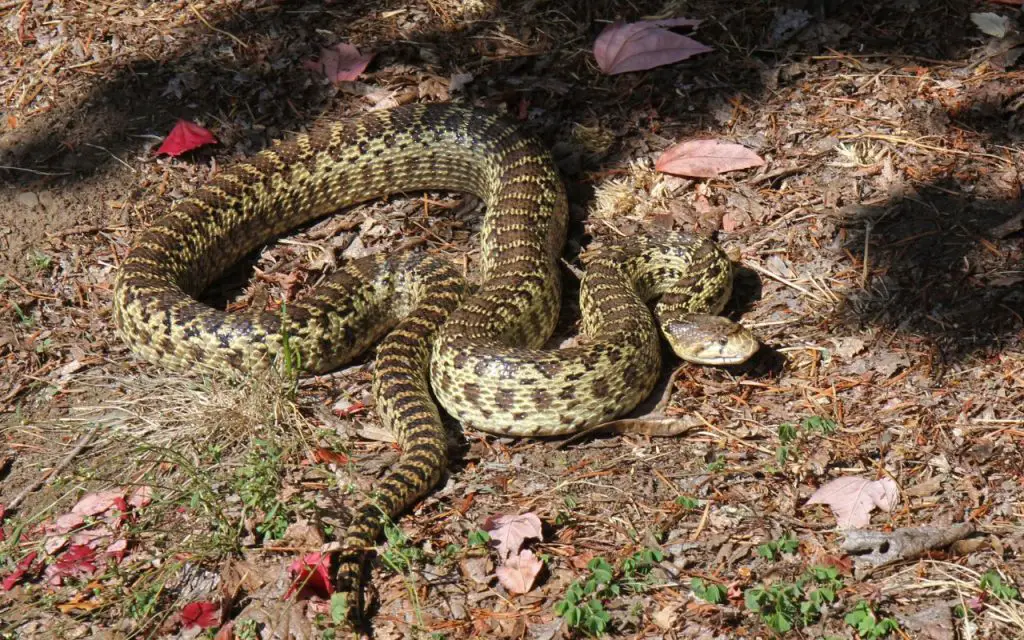
Diet
Bull Snakes are more inclined towards a rodent diet, even though occasionally they are also be seen feeding on rabbits and birds. In some areas, they also enjoy bird eggs as their diet.
They also have a taste towards ground squirrels. Most baby bull snakes prefer to feed on a rat or small mouse every four to five days, while adults will feed on larger every two weeks or so.
A significant feature of the bull snake diet is its preference towards eating Gophers. Yes, a subspecies of Gopher snake tends to eat the Gophers themselves.
Here is a list of all the dietary items for a bull snake, arranged as per their preference.
- Gophers
- Ground Squirels
- Rats/mice
- Rabbits
- Birds and their eggs
- Lizards
Gopher snakes, on the other hand, have a similar diet but are sometimes slightly more fond of small mammals, birds and lizards.
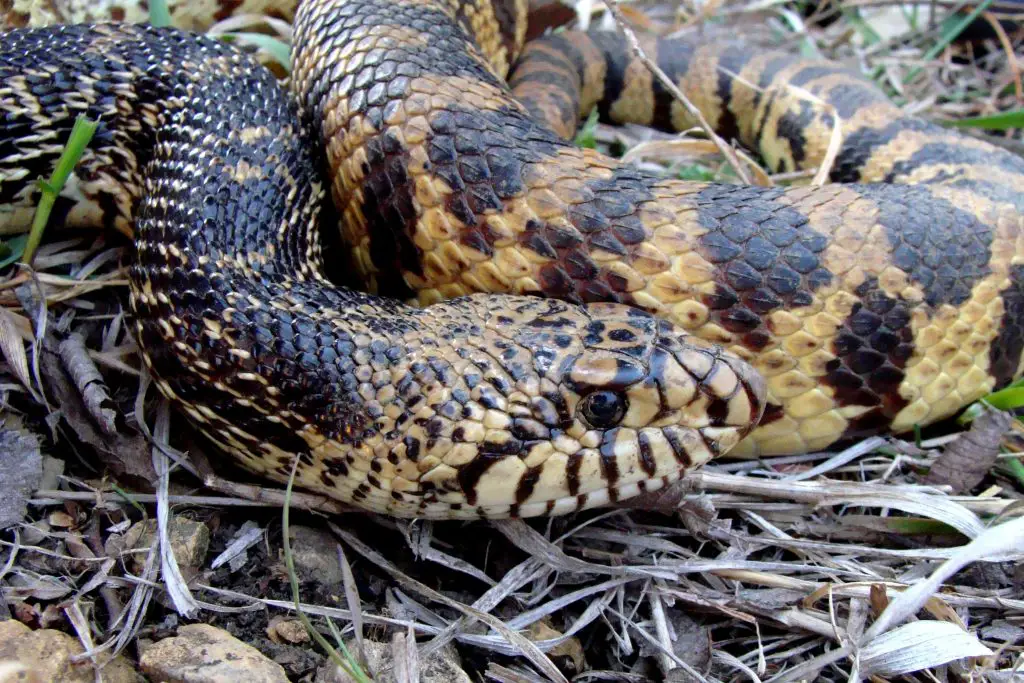
Defensive behavior
Bull snakes have a whole set of actions as their defensive behavior. When disturbed or preyed on, they prefer hissing and bellowing at first.
Both these are loud, bellows being the lesser loud of the two. Other actions include puffing up, mock striking and rattling their tail.
However, their bites do not hurt much. Moreover, they are non-venomous, so no risk of infections or any real damage.
Gopher snakes are also non-venomous. They have a similar behavior when disturbed or threatened.
They also tend to hiss, coil their bodies and shake their tales as a part of their defense mechanism. They tend to look like rattle snakes in order to warn away the enemy.
Both these snakes have a similar appearance to the rattle snake. That, combined with these defense activities, helps them warn away enemies.
Overall, the behavior is not the best way to tell these snakes apart – you should rely more on their different ranges, which we discussed earlier.
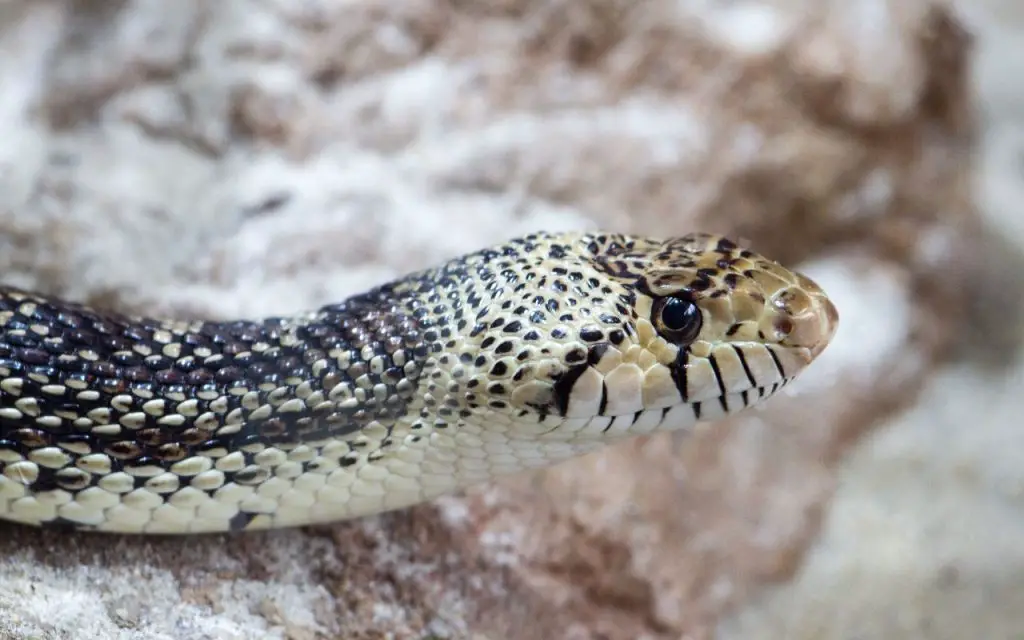
Will a gopher snake shake its tail?
Yes, Gopher snakes shake their tail as a part of their defensive behaviour. In addition, they tend to shake their tales in order to warn away enemies when threatened or disturbed.
One can notice similar behaviour in the bull snakes. Shaking or rattling tails is one of the major defense actions of bull snakes, apart from hissing.
This is an activity that both these species of snakes prefer, for appearing as a rattle snake. Looking like a rattle snake warns away a lot of enemies.
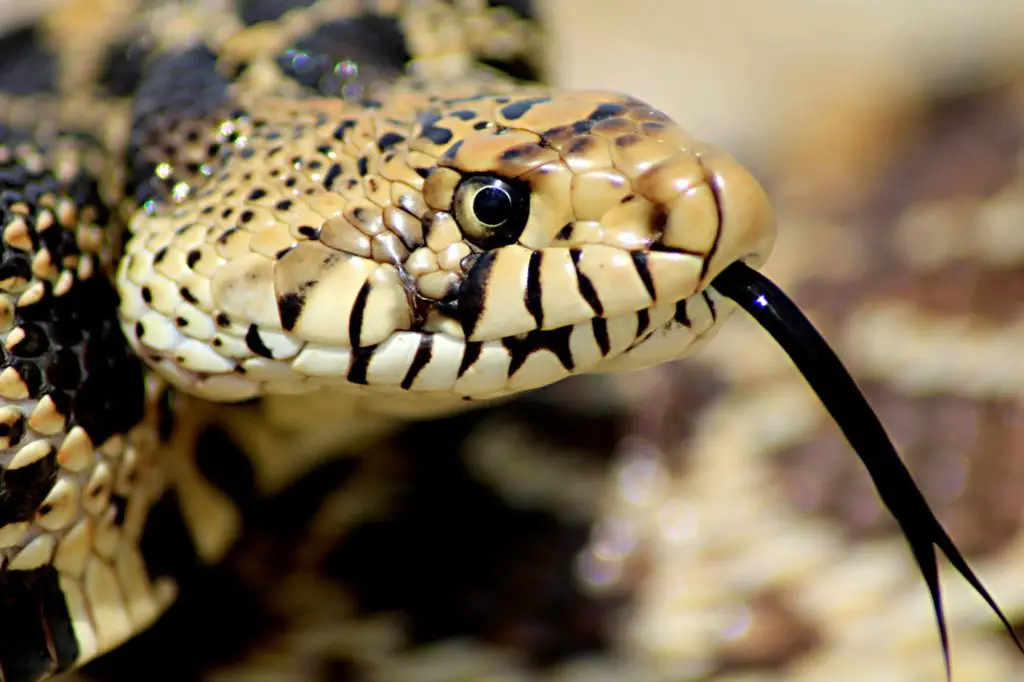
Scientific names
As stated in the beginning, Bull snakes are members of the species of Gopher snakes. Therefore, they somewhat form a cousin to each other.
Scientifically, the subspecies of Bull snake is termed Pituophis catenifer sayi. On the other hand, Gopher snakes come under multiple other subspecies, including Pituophis catenifer deserticola and Pituophis catenifer affinis.
There a total of 7 Gopher Snake subspecies currently recognised, all with different scientific names and ranges – check out the table below:
| Common Name | Scientific Name |
| Bull Snake | Pituophis catenifer sayi |
| Sonoran Gopher Snake | Pituophis catenifer affinis |
| Great Basin Gopher Snake | Pituophis catenifer deserticola |
| Pacific Gopher Snake | Pituophis catenifer catenifer |
| San Diego Gopher Snake | Pituophis catenifer annectens |
| Santa Cruz Island Gopher Snake | Pituophis catenifer pumilis |
| San Martin Island Gopher Snake | Pituophis catenifer fulginatus |
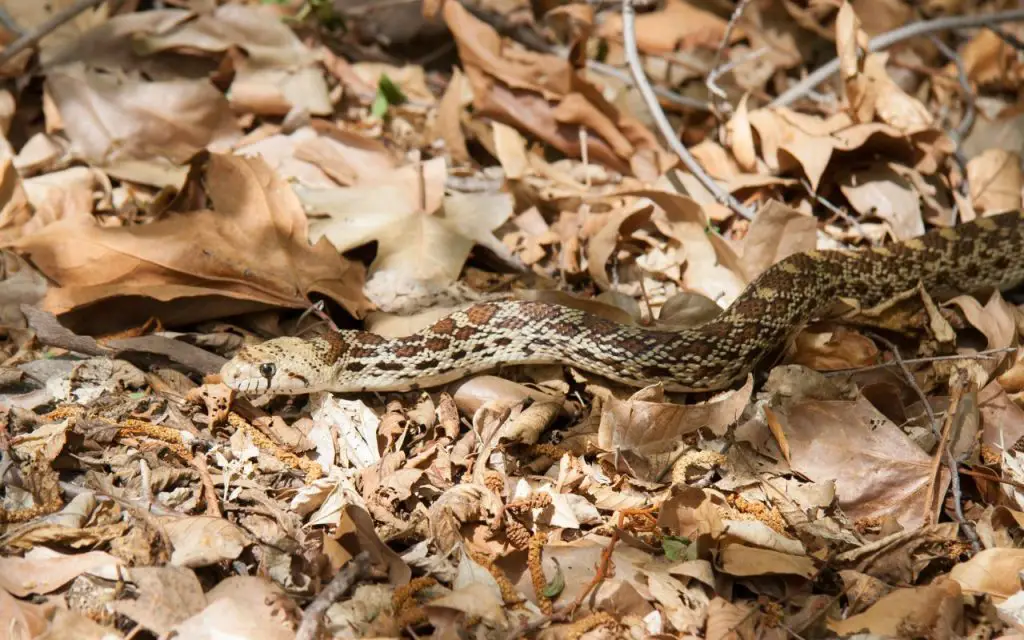
Why is it called a bull snake?
It is confusing why a wild snake is named after a farm animal. The reason is explained below.
As discussed above, Bull snakes produce loud hisses and bellows as a part of their defense mechanism. These are mainly because of their specially adaptive larynx.
They make loud and grunting sounds in order to appear bigger and scarier to the enemy. This makes the predator pause and gives it a second thought.
These loud and intense sounds that they produce remind people of bulls. So that is why they’re called ‘bull’ snakes.
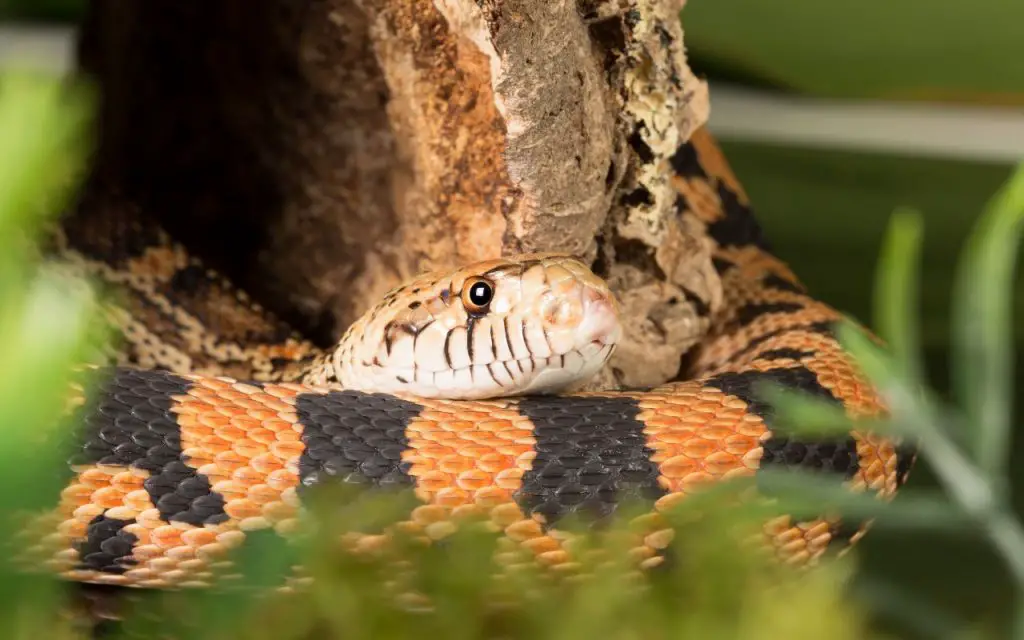
FAQ relating to bull snake vs gopher snake
Do bull snakes eat gophers?
Several surveys of their dietary habits in the wild account for their preference towards eating gophers. This is partly due to the fact that they also enjoy using gopher burrows as their hideouts. A great way to get an empty burrow is to eat the residents first!
The first preference of bull snakes in their diet is that of mid-sized rodents, so gophers or ground squirrels suit them just fine.
How do I identify a gopher snake?
A lot of times, if you see a bull snake, you might mistake it for a gopher snake. The reason is simple, being a part of the same species, they have a similarity in their resemblance.
One of the most significant resemblances in their appearance is the pattern on their bodies. Both species have a similar chain-like pattern on their bodies.
These patterns mostly come in brown, black and yellow-brown variants.
However, gophers and bull snakes have a few differences in appearance.
- The bull snakes have more contrasted color mostly, while the gophers are paler and come with a more muted color.
- They do not grow as long as bull snakes do. Their maximum growth is up to 4 to 5 feet, while the bull snakes grow up to 8 feet.
Can a gopher snake hurt you?
Gopher snakes are primarily non-aggressive. They are even less aggressive and harmful than bull snakes. A reason that they are popularly considered a pet.
However, if disturbed or threatened, they have a set of activities that they perform in order to warn away the predator. This includes loud hissing, shaking and rattling of tales, coiling up and mock striking towards the enemy.
They prefer shaking their tales and making loud sounds to appear as a rattle snake. An appearance resembling a rattle snake scares away most enemies.
If not disturbed, gopher snakes are peaceful around human beings.
How can you tell a bull snake?
A bull snake again looks very similar to the Gophers. Similar defensive mechanisms and dietary preferences might confuse anyone.
Their skin patterns are also very similar, which can confuse anybody.
However, the few distinct qualities of a bull snake that marks the differences between the species are:
- Bull snakes grow up to 8 feet, while gophers can only reach 5 feet. Therefore, there is a considerable difference in size between the two species.
- Bull snakes come in various colors, thanks to their substantial natural distribution in different parts. However, they are mostly brightly colored, while the gophers have a more mute and pale complexion.

